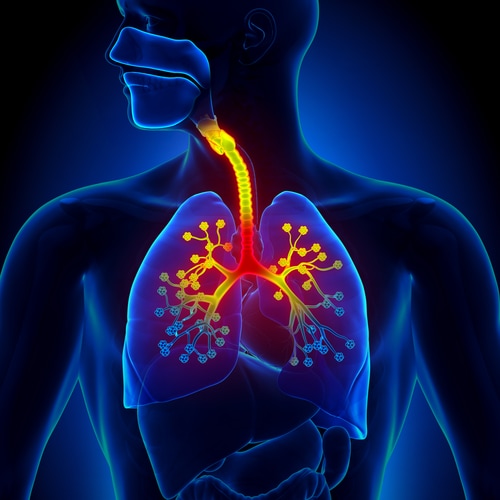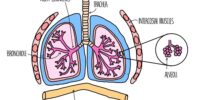Top Respiratory Disorders And Diseases

Respiratory disorders and diseases are a significant cause of morbidity and mortality worldwide. These conditions can range from mild, such as the common cold, to severe, life-threatening conditions like lung cancer.
The respiratory system is responsible for the exchange of oxygen and carbon dioxide in the body and plays a crucial role in maintaining the body’s homeostasis. Any disruption to this system can lead to respiratory disorders and diseases, which can significantly impact an individual’s quality of life.
This article aims to provide an overview of the most common respiratory disorders and diseases, their causes, symptoms, and treatment options. The focus will be on asthma, chronic obstructive pulmonary disease (COPD), pneumonia, lung cancer, bronchitis, tuberculosis (TB), pulmonary embolism, and sleep apnea.
Understanding these conditions’ basics can help individuals recognize the symptoms, seek appropriate medical care, and manage their condition effectively. Additionally, understanding the risk factors and treatment options can help individuals work with their healthcare providers to develop a personalized treatment plan and improve their overall quality of life.
Key Takeaways
- Respiratory disorders and diseases are a major cause of morbidity and mortality worldwide, and any disruption to the exchange of oxygen and carbon dioxide in the body can lead to these conditions.
- Common respiratory disorders and diseases include asthma, COPD, pneumonia, lung cancer, bronchitis, TB, pulmonary embolism, and sleep apnea.
- Treatment and prevention options vary depending on the specific condition, but early diagnosis and management are crucial for improving outcomes.
- TB is a significant global health issue, particularly for high-risk populations such as those living with HIV/AIDS, individuals with weakened immune systems, and those in low-income countries with limited access to healthcare.
Asthma: Causes, Symptoms, and Treatment Options
Asthma is a chronic respiratory disease that affects millions of people worldwide. It is characterized by airway inflammation, bronchoconstriction, and increased airway responsiveness, which can lead to symptoms such as wheezing, shortness of breath, coughing, and chest tightness.
The exact causes of asthma are not fully understood, but it is believed to be a combination of genetic and environmental factors, such as allergens, pollutants, and infections.
Asthma can be managed with proper treatment and care, which typically involves the use of bronchodilators and anti-inflammatory medications. These medications can help to reduce inflammation, open up airways, and prevent or alleviate symptoms.
In addition to medication, lifestyle changes such as avoiding triggers and maintaining a healthy weight can also help to manage asthma.
Overall, it is important for individuals with asthma to work closely with their healthcare provider to develop a personalized treatment plan that meets their specific needs and helps to control their symptoms.
Chronic Obstructive Pulmonary Disease (COPD): Understanding the Basics
Chronic Obstructive Pulmonary Disease (COPD) is a serious and common respiratory condition that affects millions of people worldwide. It refers to a group of progressive lung diseases that cause breathing difficulty, including chronic bronchitis and emphysema.
COPD is primarily caused by long-term exposure to irritants such as cigarette smoke, chemical fumes, air pollution, and dust. The condition is characterized by inflammation and narrowing of the airways, making it harder for air to flow in and out of the lungs.
The symptoms of COPD include chronic cough, shortness of breath, wheezing, chest tightness, and frequent respiratory infections. The disease is progressive and can lead to severe disability and even death if left untreated.
Unfortunately, there is no cure for COPD, but early diagnosis and treatment can help manage the symptoms and slow down the progression of the disease. Treatment options include medications, oxygen therapy, pulmonary rehabilitation, and in some cases, surgery.
Quitting smoking and avoiding environmental irritants can also help prevent the development and progression of COPD.
Pneumonia: A Common Respiratory Infection
Pneumonia, a common infection of the lungs, is caused by bacteria, viruses, or fungi and can lead to severe respiratory symptoms. The most common symptoms of pneumonia include cough with sputum production, fever, chills, shortness of breath, chest pain, and fatigue. The severity of the symptoms can vary depending on the type of pathogen causing the infection and the individual’s overall health status.
Pneumonia can affect anyone, but certain groups are at higher risk, including infants, young children, elderly individuals, and those with weakened immune systems. Treatment for pneumonia typically involves antibiotics for bacterial infections and antiviral or antifungal medications for viral or fungal infections. In severe cases, hospitalization may be necessary, particularly for individuals with underlying medical conditions or weakened immune systems.
Prevention measures include vaccination against bacterial and viral pathogens and maintaining good hygiene practices to reduce the risk of infection.
Lung Cancer: Risk Factors and Treatment Options
Lung cancer, a malignant disease that affects the cells of the lungs, is influenced by various risk factors and can be treated using several options.
The primary risk factors for developing lung cancer are smoking, second-hand smoke, exposure to radon gas, and exposure to occupational carcinogens such as asbestos, arsenic, and diesel exhaust.
Smoking is the most significant risk factor, accounting for approximately 85% of all lung cancer cases. Even individuals who quit smoking after being a long-term smoker are at an increased risk of developing lung cancer compared to those who never smoked.
There are several treatment options available for individuals diagnosed with lung cancer, including surgery, radiation therapy, chemotherapy, and targeted therapy.
The treatment plan recommended will depend on the type and stage of the lung cancer. Surgery involves the removal of the tumor and possibly surrounding tissue and lymph nodes.
Radiation therapy uses high-energy radiation to kill cancer cells and may be used alone or in combination with other treatments.
Chemotherapy involves the use of drugs to kill cancer cells and is often used in advanced stages of lung cancer.
Targeted therapy uses drugs that specifically target cancer cells’ vulnerabilities, such as genetic mutations, and may be used in combination with other treatments.
Bronchitis: Causes, Symptoms, and Treatment
Bronchitis is a common respiratory condition that affects the air passages between the nose and lungs. It occurs when the bronchial tubes become inflamed, leading to a persistent cough, chest discomfort, and difficulty breathing.
Bronchitis can be either acute or chronic, depending on the duration and severity of the symptoms. Acute bronchitis usually lasts for a few weeks and is caused by a viral infection. On the other hand, chronic bronchitis is a long-term condition that is often associated with smoking or exposure to air pollution.
The causes of bronchitis can vary, but the most common ones are viral infections, bacterial infections, and environmental factors such as smoking or air pollution.
Regardless of the cause, the symptoms of bronchitis can be treated with medications such as bronchodilators, expectorants, and antibiotics. In addition, lifestyle changes such as quitting smoking and avoiding exposure to pollutants can help prevent and manage the condition.
Overall, bronchitis is a manageable respiratory condition that can be effectively treated with early diagnosis and appropriate treatment.
Tuberculosis (TB): An Infectious Disease of the Lungs
Moving on from bronchitis, we now turn our attention to tuberculosis (TB), which is an infectious disease that primarily affects the lungs. TB is caused by a bacterium called Mycobacterium tuberculosis and is spread through the air when an infected person coughs or sneezes. While TB can affect any part of the body, it most commonly affects the lungs and can cause symptoms such as coughing, chest pain, and fever.
TB is a serious global health issue, with an estimated 10 million people developing the disease and 1.4 million dying from it in 2019 alone. In addition, TB often coexists with other diseases such as HIV/AIDS, which can complicate treatment and increase the risk of mortality. In this section, we will explore the causes, symptoms, and treatment options for TB, as well as its impact on global health. To provide a better understanding of TB, the following table outlines key facts about the disease and its impact worldwide.
| Key Facts about TB | |
|---|---|
| Causes | Mycobacterium tuberculosis bacterium |
| Transmission | Airborne through coughs and sneezes of infected individuals |
| Symptoms | Coughing, chest pain, fever, night sweats, weight loss |
| Treatment | Antibiotics for 6-9 months |
| Global Impact (2019) | 10 million cases, 1.4 million deaths |
| High-Risk Populations | People living with HIV/AIDS, those with weakened immune systems, and individuals in low-income countries with limited access to healthcare |
TB is a highly infectious disease that requires prompt diagnosis and treatment to prevent its spread and reduce the risk of complications. While antibiotics can effectively treat TB, the emergence of drug-resistant strains poses a significant challenge to global health. As such, continued efforts are needed to improve TB prevention, diagnosis, and treatment, particularly in high-risk populations and low-income countries.
Pulmonary Embolism: A Serious Respiratory Condition
One critical respiratory condition that requires immediate attention is pulmonary embolism, which can lead to serious complications such as heart failure and even death.
Pulmonary embolism occurs when a blood clot travels through the bloodstream and lodges in the lungs, obstructing blood flow. This can lead to reduced oxygen levels in the blood, which can cause damage to the lungs and other organs.
Symptoms of pulmonary embolism can include shortness of breath, chest pain, coughing up blood, and rapid heart rate. It is important to seek medical attention immediately if these symptoms arise, as early intervention can greatly improve the prognosis of the condition.
Treatment for pulmonary embolism typically involves the use of blood thinners to prevent further clotting and allow the body to dissolve the existing clot. In some cases, surgery may be necessary to remove the clot or repair any damage to the lungs or blood vessels.
Overall, prompt diagnosis and treatment are key to managing pulmonary embolism and preventing serious complications.
Sleep Apnea: Causes, Symptoms, and Treatment Options
Pulmonary embolism is a serious respiratory condition that can lead to life-threatening complications if left untreated. In contrast, sleep apnea is a common respiratory disorder that affects millions of people worldwide. It is characterized by frequent pauses in breathing during sleep, which can cause a range of health problems if not managed properly.
In this subtopic, we will discuss the causes, symptoms, and treatment options for sleep apnea. Sleep apnea can be caused by a variety of factors, including obesity, alcohol consumption, and smoking. The condition is also more prevalent in men, as well as in people with a family history of sleep apnea.
Symptoms of sleep apnea include loud snoring, gasping or choking during sleep, daytime sleepiness, and difficulty concentrating. If left untreated, sleep apnea can lead to a range of health problems, including high blood pressure, heart disease, and stroke.
There are several treatment options for sleep apnea, including lifestyle changes, such as losing weight, quitting smoking, and avoiding alcohol and sedatives. Additionally, continuous positive airway pressure (CPAP) therapy is a common treatment option that involves wearing a mask over the nose and/or mouth during sleep. The mask is connected to a machine that delivers a continuous flow of air, which helps to keep the airway open and prevent pauses in breathing.
Surgery may also be an option in some cases, although it is typically reserved for severe cases of sleep apnea. Overall, early diagnosis and treatment of sleep apnea is crucial for preventing complications and improving quality of life.
Conclusion
Respiratory disorders and diseases are a major health concern worldwide.
Asthma, COPD, pneumonia, lung cancer, bronchitis, TB, pulmonary embolism, and sleep apnea are some of the most common respiratory conditions. These conditions can affect people of all ages and can have a significant impact on their quality of life.
Some of these conditions are chronic, while others are acute and require immediate medical attention.
It is essential to understand the causes, symptoms, and treatment options for these respiratory disorders to prevent and manage their impact on individuals’ health.
Public health initiatives that promote awareness and provide education on preventive measures and early intervention can help reduce the incidence of these conditions.
Research and development of effective treatment options can also significantly improve the outcomes for individuals with respiratory disorders.
Overall, early detection, proper management, and prevention strategies can help reduce the burden of respiratory disorders and improve the quality of life for those affected.









